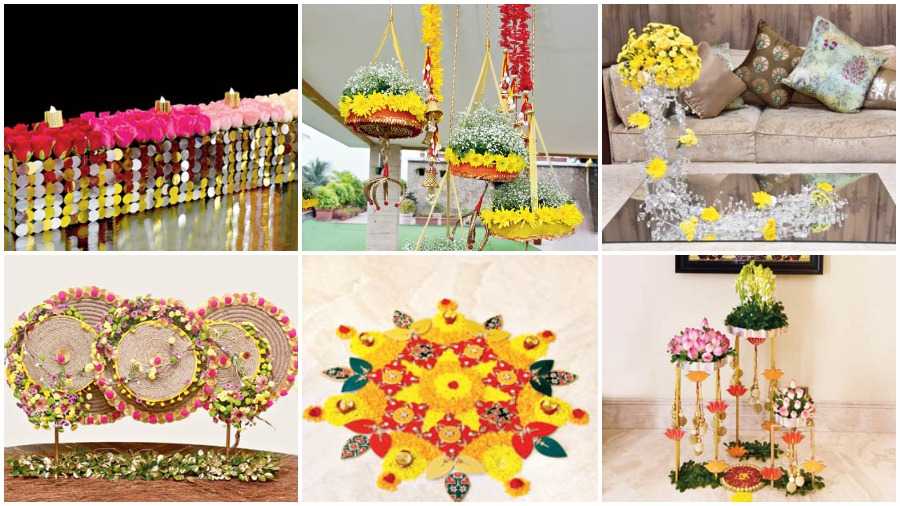Diwali is a festival of lights. Celebrated by a billion people all over the world, it is about pujas, feasts, exchange of gifts, and fireworks among friends and family. Mythologically, it’s the time to celebrate triumph of light over darkness, knowledge over ignorance, and good over evil. Temples and homes are lit with diyas, decorated with colourful rangoli and flowers everywhere. Lotus, roses, carnations, and marigolds are commonly used to make breathtaking decorations that represent joy and these flowers are all associated with deities. Sometimes, fresh flower bandhanwars (door hangings) are made, floral rangoli are designed and a variety of arrangements are placed both at home and offices.
TABLE-TOP BLING
This very simple and interesting design is supposed to be an eye-catcher. Four large pieces of moist oasis are joined together to form an elongated block. They are covered from top to bottom with lines of golden and silver round sequins. This is the most important part of the design, creating an area of dominance. The soft, fresh roses inserted on top of the oasis create a balance to the heavy visual weight created by the bling. The pink colour changes from a soft baby pink on one end to the full intense shade of pink on the other. The flowers are closely placed next to each other. Candles are placed at regular intervals; if one wishes it can be replaced by regular LED candles. This whole arrangement can be placed on an mirror base or a reflective table top, creating an expanse due to the reflection.
HANGING BASKET
These baskets of flowers and greens can adorn terraces, verandahs or even large entrances. Round or square woven baskets are used with large pieces of moist oasis fixed at the centre. The edge of the basket has a dense ring of bright yellow chrysanthemum. Yellow, oranges and reds are festive Indian colours. So flowers of these colours can be chosen. Above this, a whole bunch of delicate white gypsophila is neatly fixed on the oasis, creating a volumetric design. This pattern creates an innate rhythm due to its positioning. Some kamini leaves are placed amongst the gypsophila to create an interesting visual result. Green foliage is an important aspect of traditional simple festive designs. These baskets are further suspended with jute code/satin ribbons and so on. They are hung equidistant. A variation in height when suspended creates an interesting flow.
CARNATIONS AND CRYSTALS
This easy DIY composition is one of “lopsided” flow of design. A medium-sized cylindrical vase is filled with water to keep bright yellow carnations fresh for a few days. They are bunched and tied and placed on top of the vase on the moist oasis. This creates a focal point in the arrangement. Strings of 15 to 20 crystals are tied together. They are draped to one side over a rectangle mirror, creating a lopsided arrangement. A few single carnations are tied to these crystal strings for continuity and harmony. Some small silver gota flowers are added to these strings of crystals to add further bling to it. If the room where this arrangement is placed is well lit then the combination of crystal and mirror creates an aura of bright light reflection, illuminating the entire space. In this design the crystals form the dominant feature, with a festive look. The soft colour and texture of the flowers create an interesting contrast to the other components in this arrangement. It is a beautiful centre table-top design for the living room.
ENCHANTING FLORAL STANDS
As the name suggests, rectangular stands of different heights form the base of this design. The stands are painted golden. Traditional broad brass urli (I got mine from a friend who owns Packaging Tree) are chosen as the container for the flower arrangement. Here I have chosen lotus, rajnigandha (tuberose) and rose buds for the three urlis. The usual moist oasis is placed in the centre of these containers and the flowers are properly bunched and stacked with kamini leaves. Yellow, orange and green wooden lotus shapes are taken and stuck to the legs of the stand with an adhesive. This creates harmony and contrast to the fresh lotus flowers placed on the top. An interesting alternate pattern is also created. This height, width and depth creates a riveting aspect in the construction. Beaded latkans (hanging bead spherical balls) generate a downward line movement, taking our eyes to the floor where a cluster of fresh kamini leaves are placed at the bottom of each design. Patola or bandhej cloth rangoli is placed at the bottom centre, completed with fresh yellow marigold cluster of petals in front of it. These stands are kept at the entrance of the house to welcome guests.
CAPTIVATING RANGOLI
Rangoli is a Hindu folk art form, generally created on the floor on special festive occasion. It can be traced back to the Puranas and simply means a row of colours. It represents happiness, positivity and liveliness in a household and welcomes Goddess Lakshmi during the festival of Deepawali. The pools of energy created by specific patterns motivate and channelise positive energy in people.
The artistic repetitive pattern here is created by yellow and orange marigold petals with golden, green and Patola cloth metallic/board leaves. After the festival they can be carefully wrapped and put away and reused later for another festival. Perfectly laser-cut red boards are embellished and placed to create a pattern within a pattern. The leaves and the square-cut stencil patterns are embellished with tiny beads and stones. It adds bling to this floral rangoli composition. It creates a rhythm which draws the eye around the design through deliberate placing of components through the design, leading the viewer through one area of interest to another.
CIRCLE OF LIFE
Jute has grown in Bengal region for centuries. It was an obvious choice of component when these circles were designed. For the large circles, a thick entwined jute cord is chosen and for the smaller one a thinner variety is selected. These are made like mats on a table top with the help of glue and wires. These mats are also available in the market. Three large and three smaller jute circular structures are used in this design. The large circles are outlined with overlapping gota flowers and bright pink pom-poms and the inner ones with delicate pom pom laces. These need to be secured firmly. The size of these circles should be in proper scale in relation to its surrounding. These are firmly fixed on a wrought iron stand on each side to create stability. These circular lines possess innate rhythm and a pattern emerges, creating an interesting repetition. A variety of button chrysanthemums and other small colourful flowers are assembled and attached in a crescent shape on the sides of each inner small circles. Horizontal placements of golden-sprayed kamini leaves create line contrast with the circular above. This is largely used as a console table placement or any place against the wall.

Sunita Kanoria, trained at Pushpa Bitan, is a judge for national-level flower-arrangement competitions, and currently utilises her time and talent as a floral-decor demonstrator at various forums











